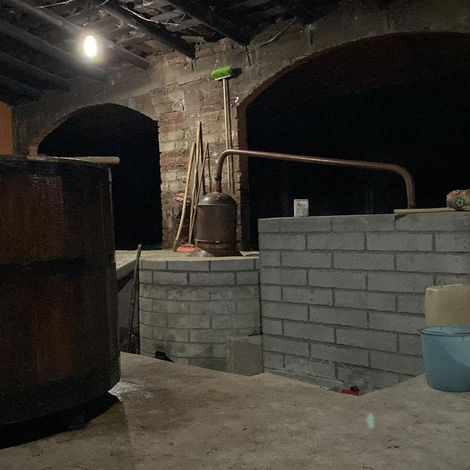top of page
_edited.png)





An authentic and artisanal process crafted by dedicated hands

Agave Espadin Heads or Piñas
A field of hearts or piñas at Oaxaca's state central valleys.

The "Jima"
When the agave is ripe (7 to 10 years) the producer begins to cut out the "pencas" leaves from the agave, this is called "jima".
Only the heads are going to be cooked since they contain most of material to be transformed into
fermentable sugars.
Only the heads are going to be cooked since they contain most of material to be transformed into
fermentable sugars.

Conical Earthen Pit Oven
Heating river stone with local wood until it reaches the perfect temperature up to 800° C.

Prepping the oven
Bagazo or the agave's dried fibers are used to cover the hot stone to avoid over burning the heads. Cooked between 3 to 4 days.

A piece of cooked agave
Once cooked (saccharification is done) and fermentable sugars are available. if we were to try this piece, it would taste sweet and tangy.

Grinding
Grinding the cooked hearts or piñas by stone wheel "Tahona" and the pull of a horse, to release most of the sugars from the fibers.

Fermentation
Wooden oak vats are used to ferment the milled material. No additives or chemicals are used. Yeasts and chemical reactions transform the sugars into alcohol. Aromatic volatile and non volatile compounds will start to form.

Verifying the must
Fermentation in wooden vats, up to 7 to 15 days

Distillation
Copper stills are used to distill the must or brew. Here we separate the components: water, alcohol and volatile components.

Mezcal
Two distillations are made and they will be divided in three parts or fractions:
Puntas: Methanol and higher alcohols
Mezcal or body: Ethanol and 80 volatile compounds.
Colas or Tails: Acetic acid and acetaldehydes
Puntas: Methanol and higher alcohols
Mezcal or body: Ethanol and 80 volatile compounds.
Colas or Tails: Acetic acid and acetaldehydes

The maestro's touch
When the last fraction of distillation "Colas" is ending, the maestro(a) is going to proceed to mix the puntas, cuerpo and colas to adjust the alcohol volume and to give an identity to this spirit that owns a range of flavors and aromas to be explored; an identity learned from its community and from his or her own knowledge.

Veneciado and Perlado
Perlado or pearls are the bubbles formed at the top of the spirit. The Maestro Mezcalero absorbs the mezcal with a reed as if it were a straw and drops it into a jícara, he observes the size, duration and uniformity of the pearls or bubbles to determine the volumen of alcohol (ethanol and adjust it: Veneciado.

Jícara de bule
One of the most common recipients to drink mezcal is called "jícara de bule or guaje" The Guaje is a tree found at Oaxaca that produces a sort of empty fruit of different sizes, is used in many ways and one of them is to be a perfect recipient to drink Mezcal!
Mezcal is complex.
It is chemistry, it is a sensory experience, it is community, it is culture; it is vast and, at the same time, unique.
A little burn and intensity in the first sip are well worth it: we release serotonin as we discover, learn, and connect with this Mexican spirit.
Sensations
and Flavours
bottom of page
